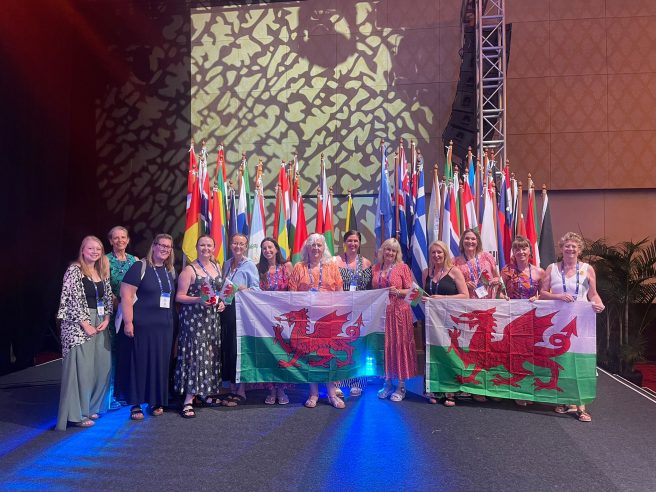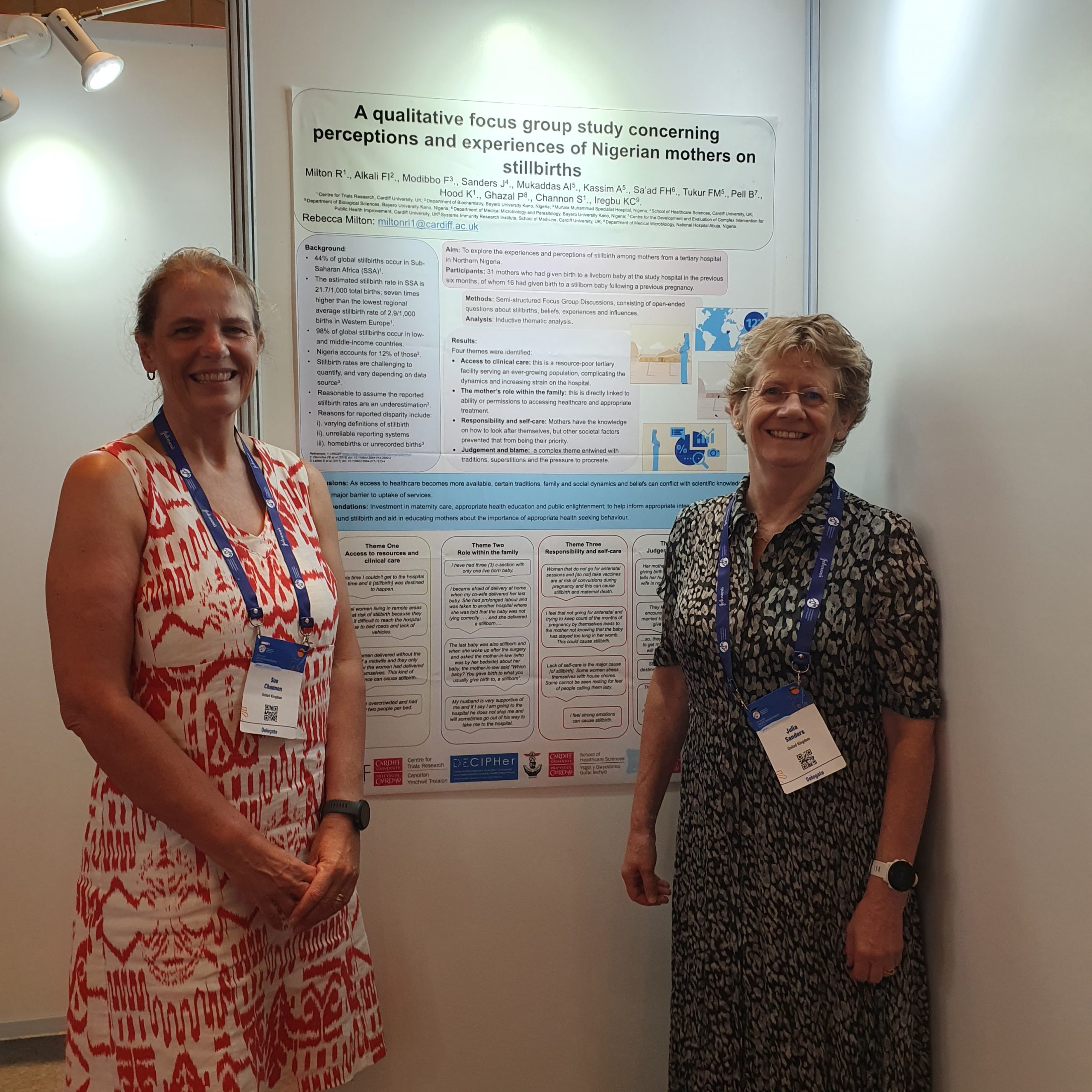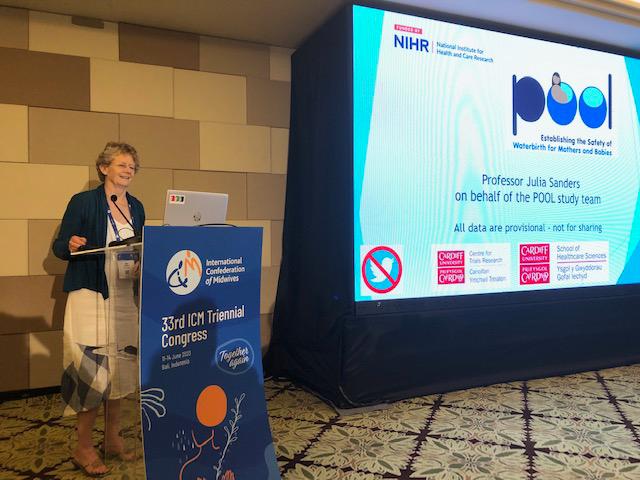33rd International Confederation of Midwives Conference: From Evidence to Reality
27 June 2023
Back in 2019 when I submitted an abstract for the 2020 International Confederation of Midwives (ICM) conference in Bali, I could never have imagined it would be a conference attendance that would be four years in the making: With a completely different poster in my bag, and with several other women’s health projects that I am working on in CTR in mind, this has been an eye-opening, humbling and inspirational conference to attend.
Firstly to declare that as a non-midwife (my background is Clinical Psychology), attending a midwifery conference for over 2000 delegates from over 120 countries was a slightly daunting prospect, but what a great group: From the first moments, people were warm and welcoming, with the biggest shout out to the wonderful group of Midwives from Wales who embraced me as one of their own.
Having worked on many women’s health-focussed research projects over the last 15 years or so with Julia Sanders, Professor of Midwifery, it would be fair to say that for a lay person I probably know a reasonable amount about Midwifery (and some might say a bit too much about the ins and outs of birth), but I have learned so much here just over a few days. It has been a great reminder of the power of immersion in a culture that is not your own, with an impact that will take a while to assimilate.
I brought a poster presentation on behalf of Becca Milton who was unable to attend, reporting on her important work on still birth in Nigeria.

I have been a co-investigator on the Pool study and Julia, as CI of the study, presented some of the preliminary data from Pool, which is tantalisingly close to reporting of results (due in the autumn), to a jam-packed room, all really wanting to hear about this important work (First question…so I know you cant give us the results but how is it looking?)

My other aim for the conference was to connect with people around Midwifery continuity of carer model (MCoC), the focus of the SIMCA study (Study of the Implementation of the Midwifery Continuity of Carer), an NIHR HS&DR funded project on which I am one of the co-investigators and that opened in March. There was a whole session specifically on MCoC, bringing together scoping reviews, a more theoretical exploration of the model and also a presentation from Professor Jane Sandall on the updated Cochrane Review, currently under review – so another tantalisingly close but no cigar taster session – again we need to wait until the autumn for that. Professor Sandall’s empassioned plea for more implementation work in this area, to be done urgently, is something I will definitely be thinking about and discussing in the months to come.
What have I learned? Close to home the lessons were about the diverse array of models across the world for registration of Midwives: I naively assumed it would be in similar professional and organisational structures around Europe, but no; The power of the political and organisational relationship between Obstetrics and Midwifery as described in particular by American delegates; The recency of professional regulation and funding in Canada; Ontario being the first province to do so as recently as 1994, and their Midwifery Associations work, leading the way in a pay equity case successfully, via legal action through the Human Rights Tribunal, was inspirational. As the presenter described, the ferocity of advocacy by Midwives on the ground for women needs to be applied to pay structures to reduce gender inequity. One of the things that struck me was the sense that the UK seems to be going in a different direction to many other nations…as for example India really starts to embrace the importance of the midwife, we seem to be moving towards a much more Obstetric driven model with ever increasing induction and caesarean section rates and it is really not clear how that tide can be turned.
The title of the conference was “Together Again: from evidence to reality” and there was definitely a thirst for research and outcomes, in particular for work that Midwives can use in their practice. It was a reminder that the power of the message, particularly when it conveys a finding that could make a positive difference to practice, be that reducing time in labour, adverse events etc, sometimes obscures the methodological foundations, which may not justify the conclusions. Non randomised studies reported headlines as if RCTs, certainties emerging from studies without the power or design to support them, association described as if causation etc were all out there, nestled in amongst some really fantastic studies: It made me think about how important research design awareness is amongst practitioners – just giving them the skills to bring an informed eye to results remains an important part of professional education for all health and social care workers if we are all going to do a good job of implementing evidence into practice. Best research moment of the conference? For me, having had some involvement with work on post-partum-haemorrhage ( the leading cause of maternal death worldwide), the results of the E-MOTIVE study, knowing how that study could change PPH practice around the globe, and how much difference that could make to maternal morbidity and mortality, was definitely a stand-out research moment.
However the session that will stay with me as a lasting memory was the plenary session “The last healthcare professionals standing – an exploration of the role of midwives in humanitarian and fragile settings” . Midwives are delivering vital sexual and reproductive healthcare in humanitarian crises across the globe, often staying with their communities under the most extreme conditions, displaying unbelievable courage, resilience and humanity. Alongside representatives from Médecins Sans Frontières and the UNFPA (the United Nations sexual and reproductive health agency) (Flor Francisconi, and Natalia Kanem), two midwives, Vira Tselyk from Ukraine and Jeffthanie Mathurin from Haiti, described their work. Vira spent 42 days under fire in a bomb shelter, separated from her family and delivered 136 babies in those 6 weeks, including triplets and twins. As she said “the power of the babies crying was louder than the loudest shell.. The cry helps us to carry the light of hope”.
The young Haitian midwife followed with a heart-rending, powerful description of life in the increasingly lawless, gangsterised country: The despair at the lack of government intervention, the level of gender-based violence and the kidnapping and rape of midwives just going about their work, or indeed taken from their homes. It was a plea to the international community to not forget Haiti and there was a profound sense that because it is Haitian on Haitian violence, rather than an invasion, they were being judged as somehow less deserving in the international arena. Listening to these two Midwives there was no doubt just how important that international support is and also just how pivotal the role of the Midwife is in global health.
- December 2025
- October 2025
- June 2025
- May 2025
- April 2025
- March 2025
- February 2025
- December 2024
- November 2024
- October 2024
- September 2024
- July 2024
- June 2024
- May 2024
- April 2024
- March 2024
- December 2023
- November 2023
- September 2023
- July 2023
- June 2023
- April 2023
- March 2023
- February 2023
- December 2022
- November 2022
- October 2022
- September 2022
- August 2022
- July 2022
- June 2022
- May 2022
- April 2022
- March 2022
- February 2022
- January 2022
- November 2021
- September 2021
- July 2021
- June 2021
- May 2021
- March 2021
- February 2021
- December 2020
- November 2020
- September 2020
- August 2020
- July 2020
- January 2020
- December 2019
- October 2019
- September 2019
- July 2019
- June 2019
- May 2019
- April 2019
- February 2019
- December 2018
- November 2018
- October 2018
- September 2018
- August 2018
- July 2018
- June 2018
- May 2018
- April 2018
- March 2018
- December 2017
- October 2017
- August 2017
- July 2017
- June 2017
- May 2017
- April 2017
- March 2017
- February 2017
- January 2017
- December 2016
- October 2016
- August 2016
- June 2016
- April 2016
- March 2016
- February 2016